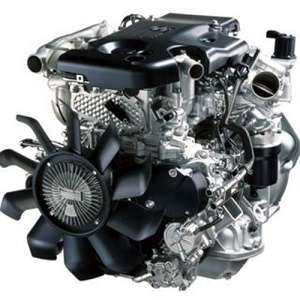4x4 Off Roading ›› Mechanical ›› Diesel Engine Workings
How Diesel Engines Work
DIESEL ENGINE WORKING: Diesel engines and petrol engines are very similar - but also different. We tell you how a diesel engine works. This includes the 'strokes' of the pistons and diesel injection systems.
There is an easy way to remember how a diesel engine works. Use the phrase 'suck squeeze bang blow'. This refers to a cycle of 4 strokes known as the OTTO cycle.
First of all, air gets drawn into the cylinder (suck). The air is then compressed by the movement of the piston (squeeze). Fuel is injected before the piston reaches the top of the cylinder.
The compression raises the temperature of the air; this causes the fuel to combust (bang). Finally, the waste gases get forced out of the cylinder (blow) and into the exhaust system. Job done - or is it?
Diesel Engine Function: Technical Data
Stroke 1: Induction
- The inlet valve opens as the piston moves down the cylinder.
- Air (only) gets drawn into the cylinder.
- The inlet valve closes just before bottom dead center (BDC).
- Both valves close and the induction stroke ends.
Stroke 2: Compression
- The piston moves up the cylinder towards top dead center (TDC). Air in the cylinder gets compressed. This increases its temperature to approximately 600° Celsius.
- Diesel gets injected in an atomised form at approximately 20° before TDC.
- Both valves close and the compression stroke ends.
Stroke 3: Ignition
- The temperature in the cylinder causes the diesel to ignite.
- This causes a huge increase in pressure, forcing the piston down the cylinder towards BDC.
- The exhaust valve opens immediately before BDC. This lets the gasses out and the ignition stroke ends.
Stroke 4: Exhaust
- The exhaust gases get forced out of the exhaust valve as the piston travels past BDC towards TDC.
- The inlet valve opens just before TDC and the cycle starts again.
OTTO Cycle Facts
- The cycle was first patented in 1854.
- They made the first prototype in 1860.
- We understand the cycle got named after a German mechanical engineer - Nicolaus Otto.
 Diesel Engine Facts
Diesel Engine Facts
- Diesel engine blocks are usually made from steel.
- The system will operate at a compression ratio of approximately 14:1 to 23:1.
- The air/diesel mixture ratios of a diesel engine can vary right through the range. But these are the general figures:
- Idle speed up to 60:1
- Acceleration - 20:1
- Cruise - 100:1
Injection Systems
Diesel fuel injection systems have many functions. The priority is to inject fuel into the combustion chamber (cylinder). It needs to be the correct mixture, delivered at the correct time, and at the correct position.
The system also has to inject the correct quantity of fuel to match throttle position and engine speed. Manufacturers use 3 different types of fuelling systems to deliver fuel to the engine. They are mechanical, electronic, and common rail.
Note: Mechanical and electronic systems are both employed to make a diesel engine work.
Mechanical and electronic systems both use two different types of high pressure pump. It can be in-line or rotary. The pump pressurises the fuel to the correct pressure needed. It then sends the correct amount of fuel to the injectors and at the right moment.
The fuel gets sent from the pump to the injectors via high pressure pipes (usually made from steel).
As the fuel reaches its injection pressure, it will force the injector open. Thus, delivering fuel to the cylinder. Both mechanical and electronic systems will use a lift/transfer pump.
Pro Tip: This is a low pressure pump that delivers fuel from the diesel tank to the main pump. It operates using a system of low pressure pipes usually made from rubber or plastic.
Common Rail
The common rail system also has a lift/transfer pump and a high pressure pump. The high pressure pump pressurizes the fuel which is then sent to a rail connected to all injectors.
Unlike the other systems, the injectors are solenoids controlled by the ECU (Electronic Control Unit). The ECU uses information from the vehicle sensors to control when the injectors need to deliver the fuel.
Cold Start Injectors
A cold start injector is usually located in the inlet manifold. It gets used to supply extra diesel fuel to the engine when it is cold. Thus, it creates a richer mixture to assist starting the engine.
Glow Plugs
Unlike petrol engine workings, diesels do not use a spark plug to ignite the fuel. Instead, a diesel engine relies on compression in the cylinder creating heat to ignite it.
When starting, if a diesel engine block is cold, the heat created by the compressed air gets dissipated through the cold block.
To resolve this, a diesel engine uses glow plugs to provide extra energy. Heater plugs warm the air in the cylinder on starting. This principle warms the block and reduces the amount of heat dissipation.
This is important when the engine attempts to start allowing the fuel to get ignited. Thus, the engine becomes easier to start during the cold season.
That basic explanation answers the question: How does a diesel engine work?
You might also enjoy reading about...
Search through our expanding list of common mechanical problems with cars that can destroy petrol and diesel engines with some solutions and easy fixes.